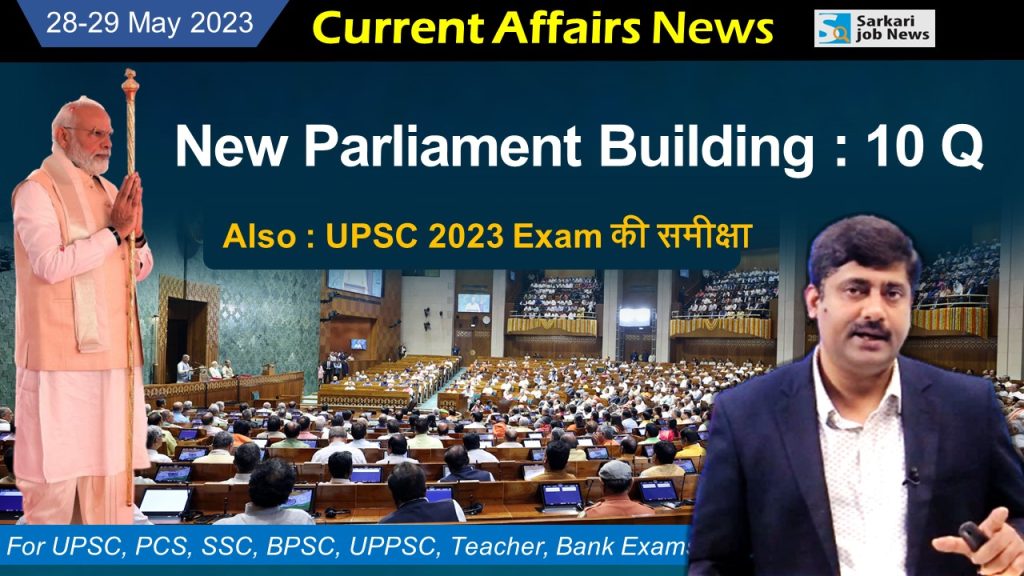This is the current affairs of 28 & 29 May 2023. Here are 10 questions and answers of daily current affairs for better preparation of competitive exams for government jobs.
PDF Download: Click here
1. Who inaugurated the new Parliament House?
a. President
b. Vice President
c. Prime Minister
d. Speaker
Answer: c. Prime Minister

– Prime Minister Narendra Modi inaugurated the new Parliament building on May 28, 2023.
– It is a magnificent building. Its beauty is unparalleled.
– However, the inauguration of the temple of democracy took place without the opposition, without the President.
About the Parliament Building:
– Foundation Stone: PM Narendra Modi on December 10, 2020.
– Inauguration: PM Narendra Modi on May 28, 2023.
– A multi-faith assembly was also organized during the inauguration.
Cost of the new Parliament Building:
– The exact cost of the construction of the new Parliament building is unknown.
– The initial contract was awarded to Tata Projects for 861.9 crore rupees, but the cost increased to 971 crore rupees by the time the project commenced.
– Since then, government officials claim that the cost has risen to 1,200 crore rupees.
– This includes 200 crore rupees for artwork purchased by the Ministry of Culture.
– The government still needs to announce the final completion cost.
What will happen to the old Parliament Building?
– Its design and materials are intended to complement the old Parliament, with the hope of functioning as a single complex of two buildings.
– It will either be used as a museum or as a supportive area.
———–
2. Name the architect of the new Parliament House?
a. Sir Edwin Lutyens
b. Narendra Modi
c. Ram Sutar
d. Vimal Patel
Answer: d. Vimal Patel

– The architect of the new Parliament building is Vimal Patel.
– The construction of the building has been done by Tata Projects company.
– The new building is triangular in shape because the land on which it is built is triangular.
– According to architect Vimal Patel, the shape also signifies sacred geometry in various religions.
————
3. At which place did PM Modi install Sangol in the new Parliament House?
a. Near prime minister’s chair
b. Near the chair of the Speaker of the Lok Sabha
c. Near the chair of the chairman of the Rajya Sabha
d. Near the gate of parliament house
Answer: b. Near the chair of the Speaker of the Lok Sabha

– The priests of the Thiruvaduthurai Adheenam (Math) in Tamil Nadu presented a sengol (a ceremonial item) to PM Narendra Modi.
– After that, PM Modi placed the sengol beside the Lok Sabha Speaker’s chair. It can also be referred to as a mace.
– It is made of gold. The upper part of it represents the form of Nandi (the bull).
———–
4. Sengol, in which kingdom it was a tradition to give the new king, who was installed in the new parliament building?
a. Sakya
b. Nand
c. Maurya
d. Chola
Answer: d. Chola
– This is a replica of the scepter used in the Chola Empire.
– Used to be worn by the king/queen of the Chola Empire on ceremonial occasions. For example, during the change of power.
– The Central Government has released a website for this (www.sengol1947ignca.in).
– According to this, Sangol was handed over to the first Prime Minister Pandit Nehru on the midnight of 15 August 1947.
– Since then it has been kept in the museum of Allahabad.
– Home Minister Amit Shah says that Sengol was a symbol of transfer of power from the British. However, The Hindu says that the evidence for this fact is doubtful.
Chola Empire
– The Cholas were a Tamil dynasty of ancient India. They defeated the Pallavas in the 9th century to come to power.
– The Tamil Chola rulers built a powerful empire in South India and in other nearby countries from the 9th century to the 13th century.
– Vijayalaya was the founder of the Chola Empire. He established it in the 9th century.
– The Chola Empire on the strength of its strong navy, the places around the maritime provinces were included in their rule.
– These included countries like Maldives, Sri Lanka, Malaysia, Thailand, Vietnam, Cambodia, Indonesia, Philippines, Singapore.
———–
5. Name the gate of the new Parliament House?
a. Gyan Dwar
b. Shakti Dwar
c. Karma Dwar
d. All of the above
Answer: d. All of the above (Gyan Dwar, Shakti Dwar, Karma Dwar)
– The new parliament building is triangular and has one gate each.
– Their names are Gyan Dwar, Shakti Dwar, Karma Dwar.
– There are 12 gates in the old Parliament House. Their names are 12 from Gate 1.
————-
6. What is the theme of the Lok Sabha chamber in the new Parliament House?
a. Peacock
b. Lotus
c. Lion
d. Deer
Answer: a. Peacock
– The theme of the Lok Sabha chamber is the national bird, the peacock.
– The walls and ceiling are adorned with intricate designs of peacock feathers.
– The carpet on the floor is also based on the colors of the peacock.
– Above the chair of the Speaker in the Lok Sabha chamber and the Chairman in the Rajya Sabha chamber, there is a large Ashoka Chakra.
– The Lok Sabha chamber will have 543 to 888 seats.
– The new Lok Sabha building will not have a central hall. Therefore, joint sessions of both houses will be held in the Lok Sabha chamber.
– Based on the importance of Indian culture and Vastu Shastra, auspicious animals are depicted as guardian sculptures on all entrance doors of the building. These include elephants, horses, eagles, swans, and mythical creatures like Sharadula and Makara.
————-
7. What is the theme of the Rajya Sabha chamber in the new Parliament House?
a. Peacock
b. Lotus
c. Lion
d. Deer
Answer: b. Lotus
– Rajya Sabha chamber is decorated with red carpets with lotus as its theme.
– Rajya Sabha Chamber has 384 seats. (The Rajya Sabha Hall of the old Parliament House had 250 seats.
– Two MPs will be able to sit on a bench (chair) in Lok Sabha and Rajya Sabha and there will be a touch screen on the desk of every MP.
————-
8. The National Emblem ‘Ashoka Icon’ is installed on the roof of the Parliament House, tell its weight?
a. 5,500 kg
b. 6,500 kg
c. 7,500 kg
d. 9,500 kg
Answer: d. 9,500 kg
– The national emblem, the ‘Ashoka Chakra,’ has been installed on the roof of the Parliament building. It was installed just a few months ago.
– It weighs 9,500 kilograms and has a height of 6.5 meters.
– To support this massive bronze sculpture, a 6,500-kilogram structure was constructed on top of the Central Foyer. The Ashoka Chakra and the words ‘Satyameva Jayate’ are engraved on a stone at the entrance door.
————–
9. How many rupees coin was released by PM Modi during the inauguration of the new Parliament House?
a. 25 rupees
b. 50 rupees
c. 75 rupees
d. 100 rupees
Answer: c. 75 rupees

– On one side of the coin there is a picture of Ashoka Pillar and on the other side there is a picture of Parliament.
– It has been minted in the mint of Kolkata.
– Its diameter is 44 mm.
– This coin is made from a mixer of 50% Silver, 40% Copper, 5% Nickel and 5% Zinc.
– Parliament Complex is written on it.
– A stamp was also launched on this occasion.
————–
10. Comparison of new and old parliament house
: New Parliament House – Old Parliament House
– Area: 64,500 square meters : 24,281 square meters
– Shape : Triangular : Spherical
– Seating Capacity : 1272 : 780
– Joint Sitting: In the Lok Sabha Chamber: Central Hall
– Building Style : State of the Art : Colonial Era Construction
– Architect: Vimal Patel: Sir Edwin Lutyens and Herbert Baker
– Safety: Earthquake Resistant for Seismic Zone V : Earthquake Resistant for Seismic Zone II
– Names of the gates: Gyan Dwar, Shakti Dwar, Karma Dwar: Entrance from one to 12
Some other facts
Constitution Hall
– The new building houses a Constitution Hall, where the journey of Indian democracy has been documented.
– MPs will have the facility of lounge, dining hall and library. The building opens onto a central courtyard with a banyan tree.
Material from across India
– Construction materials have been brought from across the country for the interior and exterior construction of the new Parliament building.
– This includes sandstone from Sarmathura in Dholpur and granite from the village of Lakha in Jaisalmer, Rajasthan.
– The wood used in the interior decorations is from Nagpur, and artisans from Mumbai have led the architectural design in woodcraft.
– Artisans from Bhadohi, Uttar Pradesh, have handwoven traditional carpets for the building.

